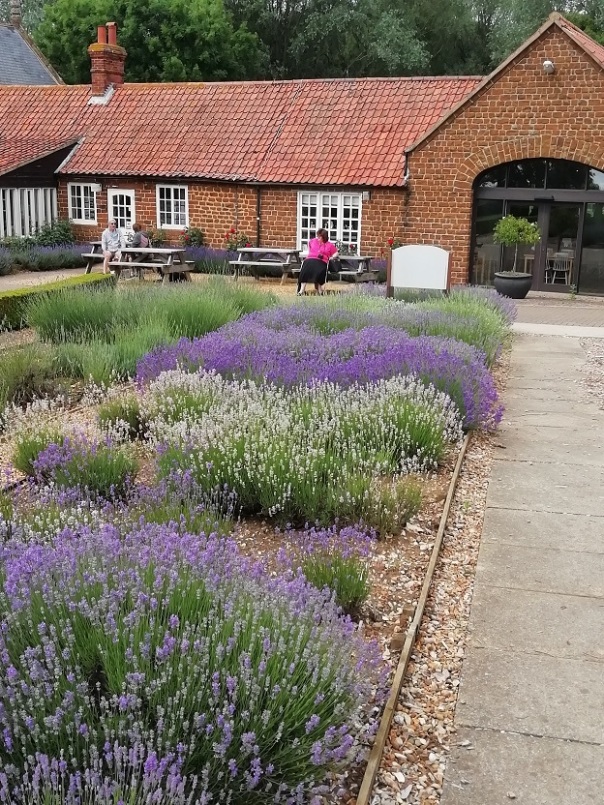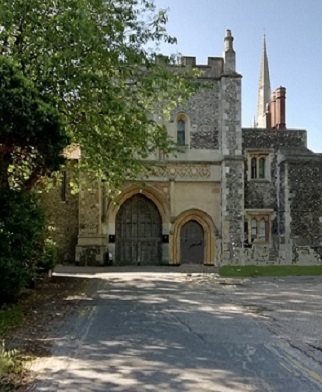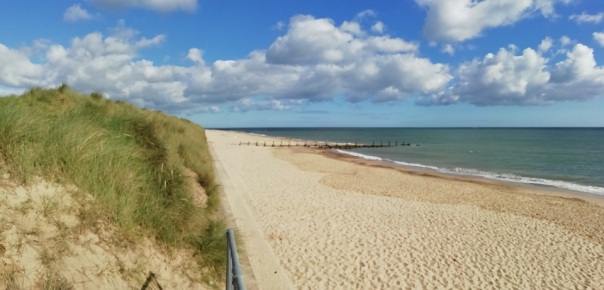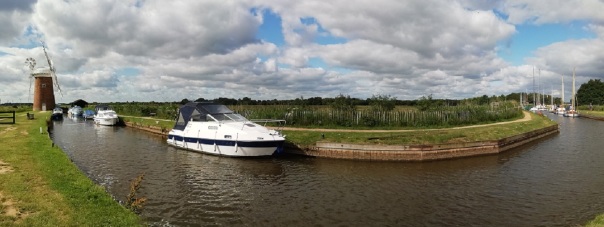There are lots of advantages to being retired but probably the greatest benefit is being able to go away when the time is just right. So for me, that rules out Bank Holidays, half-term school holidays and periods of poor weather. I’d already mapped out a couple of routes during the early part of the year and from the 24th of June my diary and the weather forecast looked good for one of them to be undertaken. The route I’d chosen was from home up into Norfolk & Sulfolk
And so on Tuesday morning I began ringing my chosen CL’s to make some bookings. I was out of luck with the first site because it was fully booked for the coming weekend. And likewise for my second choice however, I was able to book three nights at the site situated on Fakenham Racecourse. My next two bookings following on were more successful. They both had space for me. Next, I needed to pay my toll charge to use the Dartford crossing which I did on the internet. With packing complete, I was ready to set off.
As my tow was only 150 miles with an arrival time after 1pm, I delayed leaving until 10.45 and within seven miles I’d reached the M25 at Reigate Hill. The motorway was busy but free-flowing all the way to the Dartford Tunnel. I continued on the M25, then took the M11 & A11 arriving at Fakenham shortly after two. I’d chosen the site from the Caravan Club website, so I expected, as at Thirsk and Exeter, the site to be manned by CC wardens, but No – the site is independently run by Fakenham Racecourse staff. It is however, clean and tidy with water and electricity adjacent to each pitch, with pitches on both lawn or hard-standing. Access to the toilet and shower blocks is by an electronic key.
My summer caravan tours are usually planned around my liking for visiting castles, abbeys and other places of historic interest, so on my first day out I began by driving 15 miles to the village of Castle Acre. Here are the remains of a castle and next door to it a priory both built on the orders of William de Warenne on land granted to him by William the Conqueror four years after the Battle of Hastings. The Warenne family held the land for almost 450 years, surrounding the town with massive ramparts and making the Priory into an important stopping off place for royalty and pilgrims.


Later in the morning I drove another ten miles arriving at Castle Rising. Doomsday lists the owner of the castle in the 11th Century as being Bishop Odo of Bayeux, who was also the half- brother of William the Conqueror. The keep was built to impress his visitors and since it is still in good condition, it still does impress. Around the outer Bailey huge ramparts were built. By the 1500’s Henry VIII gave the castle and lands to the Howard family together with the title of Duke of Norfolk whose descendants still owns the title and land.


But by now it was after one oclock, so time to find a bench in a shady spot for some lunch. Later, after driving another three miles, I arrived at Wolferton. For over 100 years this village had probably the most famous rural railway station in the Country. Through the oak-panelled entrance hall came Queen Victoria, King Edward, King George, many of the Royal Families of Europe, and also our present Queen Elizabeth. The reason of course is the close proximity of the station to the Sandringham Estate. The last Royal train ran in 1966. The line has been lifted, however the station, although now privately owned, is open to visitors most summer afternoons.


On the way back to the site I stopped off at a lavender farm.

0-0-0-0-0-0-0-0-0-0
Today my first stop was at Creake Abbey. The Abbey started in the early 1200’s as a small chapel built by Sir Robert Nerford and his wife. Later they added a hospital whose patients were looked after by a few Augustinian monks. Thirty years later King Henry III made several donations which allowed the chapel to increase in size and numbers, so that it became a priory. But two hundred years later, the community experienced a devastating fire which reduced parts of the priory to a ruin. The nave and transepts were demolished, leaving only a modest church once again. Finally in the 16th Century the priory was devastated by plague. The monks died one by one, leaving only the abbot as the sole survivor. After his lonely death, the abbey reverted to the crown.
Another nine miles and I arrived in the ancient town of Walsingham. The main thoroughfares here are lined with medieval shops and houses.
Behind the gate-house which stands in the High Street is the ruined Abbey which was built in the 14th Century however, the church has been a place of pilgrimage since Saxon times when Edward the Confessor was on the throne. With pilgrims coming from far and wide bringing gifts, the Abbey became fabulously wealthy. Both Edward the Ist and 2nd made pilgrimages here, as did Henry VI, VII and early in his reign, did Henry VIII. But by 1537 the prior colluded with Thomas Cromwell in bringing about the closure and demolition of the monastery. For his help, the prior was granted a life pension of £100 per year. The other leading monks of the Chapter received £6 per year although the sub-prior who opposed the dissolution was charged with treason and hanged in the village square.
The entrance to the Abbey grounds is now through the Shirehall which houses a small museum and Court Room. The museum contains some early photographs of the village in past times, whilst in the Court Room are examples of the punishments handed out for what we would now consider, trivial crimes.
My next stop brought me to Binham Priory which was founded by the Norman baron, Peter des Valoines on land granted to him by his uncle, William the Conqueror in the years following the Battle of Hastings. The building took 150 years to complete with modifications and alterations going on throughout the medieval period. The community was never large; even at its peak it consisted of only 14 monks. By the time of the dissolution, it was down to six. The buildings were dismantled however, part of it was allowed to remain to be used as the church.
I still had one further visit on my list but exhaustion was beginning to take its toll so I decided to call it a day and return to the comfort of the caravan.
Tomorrow will be moving day!
0-0-0-0-0-0-0-0-0-0-0
With only 45 miles to do to reach my second site, there was no need for an early start. So I pushed it to the limit and left at 11am as per site rules. Although it was a Saturday, traffic was free-flowing and I arrived at Red House in Thurne shortly after mid-day. The site is a five pitch CC CL listed as for ‘Adults Only’.

In addition to the CL, the owner also owns a basin off the River Thurne where boats are moored, together with hired craft whose ‘crews’ are visiting the village. The CL has10Amp electricity provided at each pitch and the water supply is on a standpipe close to the house. With site fees at £12 per night, it’s extremely good value.
After lunch I set off to explore. A gate near the entrance to the site gives access to the river bank.

Across on the opposite bank stood one of the Norfolk Wind pumps built during the early 1900s to pump water from the ditches into the rivers so that the swampy ground could be used for agricultural purposes. Over the years fuel driven pumps have often been installed to replace broken wind driven machinery. Only now are some of them being restored to their original condition.
Sunday
I woke early on Sunday morning and made a snap decision that it might be a good time to visit Norwich to see the Cathedral and Castle. And so it was. I found a five-bay parking area in a tiny cul-de-sac off the street adjoining the Cathedral grounds. Not only was there space, but pay & display only applied from Mondays to Saturdays. Facing me was the high wall of the Cathedral grounds. Which was the shortest way to go? I went left and started walking……………… The long way round! But it proved to be the more interesting. First I came to the Bishop’s Palace. No entry but a lovely frontage – spoilt by parked cars.


But I enjoy the challenge of removing them. Moving on, before long I saw a plaque set into the wall – which happens to be connected to the novel I’m currently reading. It’s “Tombland” by CJ Sansom whose principal character, the hunchbacked lawyer, Matthew Shardlake is sent by a young Princess Elizabeth to Norfolk to investigate the murder of a distant relative of her mother, Anne Boleyn. Shardlake gets involved with the Kett brothers and their peasants rebellion of 1549.
 Following on from the death of Henry VIII and the consequences of the Reformation, not only in Norfolk but all over the country peasants were rising up in rebellion against the injustices of the land owners. In every case the rebellions were put down with the ring-leaders being executed.
Following on from the death of Henry VIII and the consequences of the Reformation, not only in Norfolk but all over the country peasants were rising up in rebellion against the injustices of the land owners. In every case the rebellions were put down with the ring-leaders being executed.
Eventually I found an entrance to the precincts of the Cathedral and came across the spot where Nurse Edith Cavell is laid to rest.

It was on the 12th October in 1915 when she was executed by the German Army in Brussels accused of helping soldiers avoid capture. Having been born and brought up in Norfolk, it is fitting that she is buried here.
Passing through a small arched entrance, I found myself in the cloisters. What an impressive place.
 These are said to be the largest cloisters in the Country. Gradually as I made my way around, I saw a door leading into the Cathedral. I went up the steps and entered. The place appeared empty. I felt sure I wasn’t meant to be there. It was still only 8.30.
These are said to be the largest cloisters in the Country. Gradually as I made my way around, I saw a door leading into the Cathedral. I went up the steps and entered. The place appeared empty. I felt sure I wasn’t meant to be there. It was still only 8.30.


But as I wondered around marvelling at the skill of those ancient craftsmen, I came across a few more visitors. I sat for a time looking up at the roof vaulting. On every crossing the masons have fitted a carved roof boss.

There must be hundreds of them. It seems incredible that they spent so much time carving each one, and every one different when no one would be able to see them – that is until we came along with our binoculars and telephoto lenses. They even escaped the ravages of the Reformation simply because they were inaccessible. By the time I’d wandered around the vast interior, congregation was beginning to arrive for the next service. I left through the main entrance and walked across to the arched gatehouse to the precincts.

Shortly, I found myself in the street where I’d parked however, a barrier had been erected across the entrance. Several uniformed motor-cyclists were standing around. I walked down to the far end and found several other streets were cordoned off. I asked one of the officers whether I could get out. “If you go in the next five minutes, and go that way, otherwise you can’t move for the next hour,” I was told. I went – hoping to drive to my next destination – the Castle. But it was impossible because of road closures. Soon the roads were full of hundreds of racing cyclists taking part in an event. After driving around looking for a route to the castle, I gave up. I decided to programme Tomtom for the site and return for a late lunch.
Monday
Another early awakening so after the chores were done I set off towards the coast. I headed to Horsey Gap. I reached a car park down an unmade track which I’d noted down from Google Maps. Ahead of me were the sand dunes separating the sea from the low lying land. The dunes are a protected area behind vast concrete sea defences with a fenced path way over them. With the loose sand, it was a hard climb to the top. I had the beach to myself – after all it wasn’t yet 9 oclock.

After I returned to the car, I had a coffee then set off for my next stop which was another wind-pump. In the 1900s there were 250 such pumps on the Broads, all using the power of wind to raise water from a lower to a higher level. This one at Horsey has just undergone a three year restoration project bringing it back to its former working condition. On certain days of the year it is open to visitors. Unfortunately today wasn’t one of them.

Then it was back to the car and on to my next stop which was Tesco at Stalham where I stocked up on supplies. After finishing, I wandered through the lane which lead to the High Street where I found the local church. To my surprise, it was open. So often these days village churches remain locked. Building was started in the 14th Century replacing an earlier church. Here the main attraction is the font.


It’s beautifully sculptured with carvings around the top depicting the twelve apostles. During the Reformation much damage was inflicted by removing statues, stained glass, wall paintings and other features which were considered idolatrous. Many stone carvings were roughly chiselled off, but here at Stalham the font was simply covered in plaster. Many years later when the plaster was removed, the carving was found to be in pristine condition.
After a late lunch I took a stroll along the ‘local’ river bank.
Tomorrow is moving day again.
0-0-0-0-0-0-0-0-0-0
My third stop was 60 miles away near Ipswich. The site requested that arrival should be after 1pm so I was in no great hurry to leave Red House. Google maps told me that the journey time would be just under 2 hours, which I thought was over-optimistic. I had imagined that the road between Norwich and Ipswich would be dual-carriageway, but No – it was single nearly all the way, with heavy traffic and several stoppages. So I arrived at Bungalow Farm near Hadleigh just before one. It’s a Club CL situated on a non-working farm.

Each of the five plots has it’s own water tap and a shared between two, electric outlet at 10amps. Toilet disposal is an excellent arrangement in one corner of the field with a timber-built room close by containing a vast amount of information, leaflets, and books and dvds to borrow. At the other end of the building is a very well-appointed toilet room with handbasin. Site rules say No children; No dogs. Fees per night are £16.
Wednesday.
I’d planned a circular tour for today and got away from the site by 8.15. My first stop at Saxstead Windmill turned out to be a disappointment. They had the workmen in and the sails had been removed from the mill. Without it’s sails, it just looked like a tall, narrow barn. Since No Parking signs were on display, I didn’t even stop. I drove on to my next destination, the Castle at Framlingham. The first castle to be built here was a wooden palisade built on a mound. Not until the 12th Century did Hugh Bigod start building in stone. By 1213 a later member of the Bigod family was entertaining King John at the castle. But within two years, the Bigod family had fallen out with the King and Roger Bigod had become the leader of the group of barons who intended to force King John to agree to Magna Carta.



By the 15th Century the Castle had become the property of the Howard Family but eventually the Howards fell out of favour and they had the castle taken from them. Not surprising perhaps! Henry VIII had just had their daughter Catherine executed. The Castle next became the property of Mary Tudor, Henry’s eldest daughter. It was whilst she was here that she got news that she had been proclaimed Queen. She restored the estates and the Castle to the Howard family.
By the mid-1600s the castle had changed hands again. It was bought by a local lawyer. After his death he directed in his will that the buildings within the confines of the castle should be pulled down and a poorhouse built in their place. What became the workhouse is the present brick building in the courtyard.
After lunch I drove along the coast to Dunwich. Today Dunwich is a tiny village of around 60 people and only a few cottages, but in Medieval times it was the most important seaport on the East coast with many grand public buildings, several churches and also a mint. It was the capital of the Saxon kingdom making it the tenth largest town in the Country with a population of around 4000 people. But in the two hundred years from the start of the 14th Century rising sea levels began to consume the port and town. In the tiny village museum there are models on display showing the layout of the town with several churches now below the waves. Also there is an even earlier lost Roman fort there as well. What I wonder, did the displaced residents attribute the rising sea levels to?


From Dunwich I drove the short distance up on to the higher ground where I visited the ruins of the Greyfriars Priory. The order was begun by Francis of Assisi in the 13th Century. The Greyfriars were popular with the local townspeople because one of their commitments was to provide care and treatment for the sick. Like all the others, the priory was disbanded during the reign of Henry VIII during the dissolution of the Monasteries.

On the way home I stopped off at the Snape Maltings. All the old warehouses and storage sheds where once barley was roasted for beer making have now been converted into shops, studios and a music centre. The large concert hall was the creation of Benjamin Britten and Peter Pears in the early 1950s as a venue to hold their annual Aldeburgh Festival.

Thursday.
Today’s destination was Long Melford and Bury St. Edmunds. I headed for Bury first and found a parking spot close to the Cathedral. A church has been here since the 11th Century when the abbey was formed, but in the 16th Century the church was pulled down and replaced by the present one. Not until 1914 was Bury declared a city and the parish church became its cathedral. As a cathedral, it needed something on a grander scale so in the 1960/70s the chancel was pulled down and replaced with a new tower built in the gothic style with transepts and a new choir and side chapels and cloisters. Built in the 1990s was an extention to house the new choir school. New blends with the old exceedingly well.


From the cloisters I found myself in the gardens, with a gate leading into the abbey grounds. The extent of the ruins show the vast size that the abbey must have once been. Having the tomb of the martyred King Edmund in its church ensured that it became the wealthiest abbey in the whole country. The abbey became a notable place for pilgrims.

 Also it was here that in 1214, 25 of the most powerful barons in the land met and made an oath to force King John to agree to terms in Magna Carta.
Also it was here that in 1214, 25 of the most powerful barons in the land met and made an oath to force King John to agree to terms in Magna Carta.

The boundary of the grounds is marked by the river, now little more than a ditch, but in times past, the river was once navigable. In one corner of the park are the remains of a 14th Century four arched bridge.

Close to the gatehouse is another memorial – this one, the Holocaust Memorial – is in memory of thousands all over the world who have met an untimely death, but in particular the 67 Jews who were massacred in the town in 1190.

During Medieval times whilst Jews were despised, they were also tolerated because of their money lending. They were the only people from whom one could borrow. Usury in Medieval England was forbidden to Christians. Many influential people in and around Bury were indebted to the Jewish townspeople. There were the knights who were preparing to set off on their next crusade, and it’s said that the prior was also heavily in debt to them. It is now believed that public unrest was encouraged against the town’s Jews and in the riot which followed, 67 of them lost their lives. The remainder were banished from the Country. All debts were wiped out!. Today, the only part of the abbey which remains is the gatehouse, standing in the High Street.

With my parking permit about to reach its limit, I set off for Long Melford. There, I found parking was allowed on the village Green which was close to the church. But first, it was time for some lunch and a cold beer.
This visit to Long Melford’s church has been a long time in coming – in fact, 66 years.

Back in 1953 towards the end of my college life, as part of our final assessment, we each had to write a thesis. Not only had we to write it, but also print it and bind it into a book in the College workshops.

For my subject I chose “The craft and history of stained glass work.” I remember arranging visits to various companies and studios, particularly that of Goddard & Gibbs to see the artists and craftsmen at work. It was during one of these visits that I was told about a local resident in Long Melford who was criticizing the Victorian restoration of one of their stained glass windows. According to him, a box of 14th Century fragments had been carelessly sorted and put into a window. He maintained that had more care been taken, pieces could have been arranged into identifiable objects.
Another interesting feature of the church is an alabaster plaque which is dated from 1350.

The plaque was found buried in the floor of the chancel during work carried out during the 18th Century. It is thought that it was rescued and buried to avoid possible destruction during the period of the Reformation.

By now on a hot and sultry day, I was looking forward to sitting in the shade of the caravan with a cup of tea, so I returned to Bungalow Farm where I found two new arrivals.
Sadly, tomorrow will be time to head for home.











